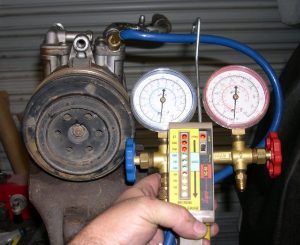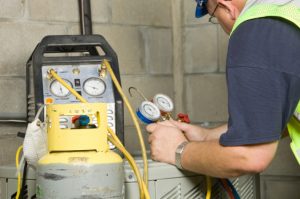Connecting Air Conditioning manifold
The manifold set will commonly have a red high-pressure side hose, as well as a blue low-pressure side hose, and then a yellow hose in the centre. The most convenient means to consider which hose pipe goes to the correct side is by thinking of a fluid. A smaller pipe size would require a lot more pressure in order to hold the same amount of liquid as the larger side. The way I always remembered though was red for hot and blue for cold. The liquid line which is the smaller is usually warm when operating. The suction line is usually cold and where you connect the blue hose. The yellow hose or centre hose is used for charging with refrigerant and other accessories.
Temperature level technique
This method can verify the proper refrigerant charge without actually weighing it in. Prior to starting the system, ensure that the evaporator and condenser coils are both clean. You will need either a superheat chart or graph reference to assist in the assessment. This chart will be specific to the condenser you are working on.
You may require other tools such as a sling or digital psychrometer to measure wet and dry bulb temperatures in various locations to properly determine the outcomes. A digital clamp thermometer will also be required for surface line temperature readings.
Before taking any measurements, run the equipment for at least 20 minutes. This will provide adequate time for the mixture of oils and refrigerants. It also will give the system time to remove most of the moisture from the indoor air. This excessive moisture can actually restrict air flow on the evaporator coil and give you a false assessment.
Liquid line temperature – ambient temp = approach temp

Superheat
Determining Superheat will indicate how efficient the system is operating. This will generally be a range from 2 to 30 degrees Fahrenheit. Superheat is the amount of heat added to the gas. Proper Superheat of the refrigerants is important for the proper efficiency and operation of a cooling system. To measure superheat attach your gauges as described above. Inside take a wet bulb temperature entering the evaporator coil using the psychrometer. Likewise, take a dry bulb temperature of the air entering the condenser coil outside.
Find where these 2 lines meet on the chart and this will tell you the required superheat. Next, subtract the Liquid line temperature measured on the suction line surface, from the saturated suction line temperature on the low side (blue) gauge in the refrigerant are on the gauge face. This will give you the actual superheat. You’ll then need to either add or remove the refrigerant to adjust to the correct predetermined rate you found on the chart.

Subcooling
Subcooling is similar to superheat set up except you will not need to take any bulb temperature readings. Simply subtract the Saturated Liquid Line temperature from the surface liquid line temperature and this will give you the subcooling. You’ll need to adjust this according to the rated subcooling rate indicated on the rating plate of the appliance.
It’s important to achieve the proper subcooling or superheat reading for either type of system to work efficiently and properly.



